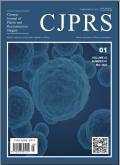Large necrosis of the scalp following temporal catheter placement in an infant with severe acute malnutrition: A case report
Chinese Journal of Plastic and Reconstructive Surgery
Pub Date : 2024-12-01
DOI:10.1016/j.cjprs.2024.10.001
引用次数: 0
Abstract
Scalp necrosis is uncommon in malnourished children, yet temporal catheterization is frequently observed in pediatric hospital settings. The condition is characterized by a black, hard, and unresponsive scalp. Etiologies such as temporal arteritis, burns, and Takayasu’s disease, have been proposed. There is a decline in the use of peripheral catheter monitoring in hospitals. War-related food shortages and social instability significantly affect the trauma and risks that undermine the health, social, and psychological well-being of children. This report describes the case of a 5-month-old infant suffering from severe acute malnutrition following the abduction and subsequent release of his mother by armed individuals after one and a half weeks. The infant, who underwent temporal catheterization for medication administration, presented with extensive scalp necrosis. The necrotic tissue was surgically removed, and the malnutrition was successfully treated, resulting in a favorable clinical outcome. The mother received comprehensive mother-child care from a psychologist.
严重急性营养不良婴儿颞叶导管置入后大面积头皮坏死一例报告
头皮坏死在营养不良的儿童中并不常见,但颞叶导管置入术在儿科医院经常被观察到。这种病的特点是头皮发黑、发硬、无反应。病因如颞动脉炎、烧伤和Takayasu病已被提出。医院外周导管监测的使用率有所下降。与战争有关的粮食短缺和社会不稳定严重影响了损害儿童健康、社会和心理福祉的创伤和风险。本报告描述了一名5个月大的婴儿在其母亲被武装人员绑架并在一周半后获释后患上严重急性营养不良的案例。婴儿,谁接受颞叶导管给药,表现为广泛的头皮坏死。手术切除坏死组织,成功治疗营养不良,临床效果良好。这位母亲从一位心理学家那里得到了全面的母子照顾。
本文章由计算机程序翻译,如有差异,请以英文原文为准。
求助全文
约1分钟内获得全文
求助全文
来源期刊

Chinese Journal of Plastic and Reconstructive Surgery
Surgery, Otorhinolaryngology and Facial Plastic Surgery, Pathology and Medical Technology, Transplantation
CiteScore
0.40
自引率
0.00%
发文量
115
审稿时长
55 days
 求助内容:
求助内容: 应助结果提醒方式:
应助结果提醒方式:


